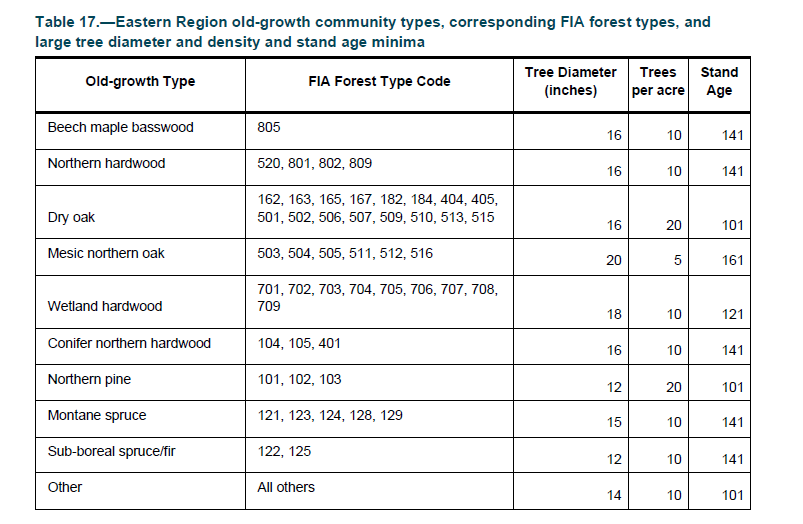| FORTYPCD | DBH_large (inches) | TPA_large | AGE (years) | Ol growth status |
|---|---|---|---|---|
| 805 | 18 | 20 | 150 | Old growth |
| 805 | 20 | 20 | 160 | Old growth |
| 701 | 19 | 25 | 140 | Old growth |
| 701 | 12 | 5 | 140 | Not old growth |

Old-growth forests are valuable in any diverse landscape. They contain large trees that store an incredible amount of carbon, have a diversity of age classes and species, and contain abundant dead wood that are needed for wildlife habitat. They also provide forest structure and composition that set them apart from any managed forest.
In 2022, an Executive Order to the USDA Forest Service required the agency to “define, identify, and complete an inventory of old-growth and mature forests on Federal lands.” This led to research that quantified the extent and distribution of mature and old-growth forests in the US. The primary findings were what you might expect: (1) it’s difficult reduce something complex like an ecologically-rich forest to a label of “old-growth forest” or not and (2) there aren’t vast areas of old-growth forests in the US.
A study by Pelz et al. 20231 showed 25 million acres of old-growth forests across National Forest System lands, with the majority of those in the western US states. National Forests are much less common in the eastern US, with only 300,000 acres of old-growth forests, representing 3% of the total area of National Forest System lands in the east.
Quantifying old growth in eastern forests
In the eastern US, the task of identifying old-growth forests was primarily taken from the work of Tyrell et al. 19982. The work from this study classified forest types used in the Forest Inventory and Analysis Program into one of ten old-growth types.
To be considered an old growth forest, forest inventory measurements should be used to determine three key attributes:
- Is a minimum diameter met for the largest trees in the stand?
- Is there a minimum number of number large-diameter trees in the stand?
- Is the stand age greater than a minimum value?
For example, to be considered an old-growth northern hardwood forest, the stand needs to be a minimum of 141 years old and there need to be a minimum of 10 trees per acre that are at least 16-inches in diameter. This is summarized on pages 45-46 in this USDA report:

To assist in identifying stands that meet old-growth forest conditions, this R function might help. Four variables are required:
- FORTYPCD = the FIA forest type code,
- DBH_large = the minimum diameter for the largest trees in the stand,
- TPA_large = the minimum number of number of trees per acre >= DBH_large, and
- AGE = the minimum value of stand age (years).
Consider the following example with two stands each in the Hard maple / basswood (FORTYPCD = 805) and Black ash / American elm / red maple (FORTYPCD = 701) forest types. The last stand is the only one that doesn’t meet old growth conditions: while it is older than the minimum stand age to be considered old growth in wetland hardwoods (121 years), it does not have enough large trees per acre to meet the old growth definition (at least 10 trees per acre at least 18 inches in diameter).
Identifying whether or not a forest is old growth is subjective, and many ecologists spend time discussing and analyzing the “old growthiness” of forested ecosystems. But these resources provided by the USDA Forest Service can give you a start in identifying and evaluating the extent of old growth in forests in your region.
–
By Matt Russell. Sign up for our monthly LinkedIn Newsletter for news, comments, and insights for professionals that work with forests and data.
Footnotes
Pelz, K.A., Hayward, G., Gray, A.N., Berryman, E.M., Woodall, C.W., Nathanson, A., Morgan, N.A. 2023. Quantifying old-growth forest of United States Forest Service public lands. Forest Ecology and Management 549: 121437.↩︎
Tyrrell, L.E., Nowacki, G.J., Crow, T.R., Buckley, D.S., Nauertz, E.A., Niese, J.N., Rollinger, J.L., Zasada, J.C. 1998. Information about old growth for selected forest type groups in the eastern United States. St Paul, MN: USDA For. Serv. GTR NC-197. 507 p.↩︎